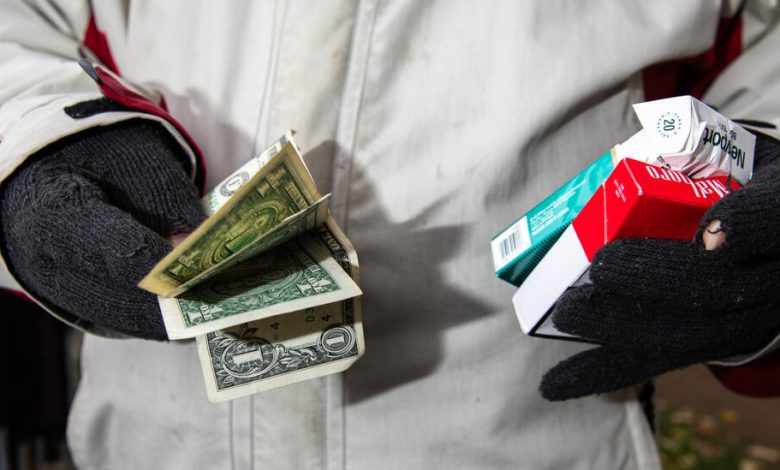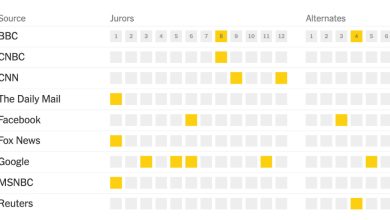Low Prices and High Hopes at a Pop-Up Market on Randall’s Island

Low Prices and High Hopes at a Pop-Up Market on Randall’s Island




Since early October, an ecosystem of barbers, vendors and chefs has sprung up outside one of the city’s largest migrant shelters at Randall’s Island Athletic Field 83.
Photographs and Text by Sebastian Sele
Dec. 10, 2023
Dusk was falling on a chilly fall day on Randall’s Island and a small crowd of people from around the world were milling around New York City’s newest pop-up market. Latin music played as the day’s last shoppers bought their dinners and vendors began packing up their tables.
Then, everyone headed home, which for most was temporarily inside one of six giant white tents set up on a nearby soccer field.
As of the end of November, more than 66,000 migrants were staying in New York’s homeless shelters, which has pushed the city’s shelter population to a record high of more than 120,000. With the system far beyond its capacity, Mayor Eric Adams has asked the Biden administration to expedite permits to allow the new migrants to work.
But on Randall’s Island, migrants are taking their fate into their own hands. Since October, the market has grown from a couple of vendors into a bustling miniature economy outside one of the city’s largest homeless complexes.
The migrants are trying to accomplish twin goals: send money to their families back home and build stable lives here. They offer their services as barbers, serve coffee and food, and sell clothes and anything else that might find a customer.
$1 Coffee, Tea and Cigarettes

A cup of tea costs $1 at Siley Niang’s stand.
Siley Niang started selling coffee and tea ($1), omelets ($4) and beef sandwiches ($6), before adding cigarettes ($1), gloves ($5) and beanies ($10) to adapt to changing demand.
Mr. Niang, a Mauritanian who left his wife and 5-year-old child behind, came by plane from Nouakchott, the Mauritanian capital, to Nicaragua, and from there by land to the U.S. border. Soon, Mr. Niang plans to move to Columbus, Ohio, where he has a brother. “I have no family here, no one to take care of me if I’m sick,” he said.
$5 Arepas
Leonardo Tromboll, a 19-year-old Venezuelan, arrived in 2021 and lives in a Brooklyn apartment. He earns $550 a week as an assistant cook at a Manhattan burger joint. On his days off, Mr. Tromboll sells arepas filled with eggs, meat or sausage for $5 each.
His work hours mean he lacks a social life and often feels lonely. But, he added, “this is New York, everything is about work.”In another couple of years he plans to return home with his savings to start his own business.
Miguel Ángel Peralta Castro, who struggled to make a living in his home city of Bogotá, Colombia, came to New York in September. He sells arepas ($5), empanadas ($4) and sodas ($2). Recently, he invested $27 for a haircutting machine, and charges $10 for a cut. He also accepts cigarettes as payment. “We don’t have enough money here, so we do barter,” he said.
$5 Clothing
“I sell clothes for the poor,” says Gustavo Fasquelle, a Honduran who lives in a brick-and-mortar homeless shelter near the Randall’s Island tents. He came to the United States in January 1993, but he sensed an opportunity when he saw the newcomers arriving this fall.
Mr. Fasquelle sells cigarettes ($1), used winter clothing ($5) and new socks ($1). He also translates for the shoppers and vendors, as a way to build up his network of customers.
$10 Haircuts
Joan Villanueba, 38, was a professional barber at home in Venezuela, and is among several barbers who have set up shop in the market. After failing to attract a single client at his initial price of $15, he lowered it to $10, and sometimes takes clients who pay less. He sees about 12 clients a day.
Yahya Well, 23, turned to barbering, although he has a degree in economics from the University of Nouakchott in the Mauritanian capital, where he is from. He left his country because one of his friends, with whom he was politically active, was killed. He makes about $20 a day, although there are days when he has no customers at all.
“They give us food here, but if you want other things, cigarettes or clothes against the cold, you have to find other ways,” Mr. Well said.
Yorvin Yonaiker, a barber from Venezuela, said he had “a lot of customers,” but he still plans to leave New York City for Detroit: “I want to be in a cheaper city where I can improve my situation step by step,” he said.
$10 Pork Chops and Beans
Every day at 11 a.m., Manuel Lopez and Liz Estrella Tellez shout “lunch, lunch!” from their stand; one day’s menu included pork chops, fried fish and fried chicken, served with beans or potatoes, for $10 each, which they prepare in a friend’s apartment in the Bronx.
The couple, who left their 1-year-old son home in Peru with Mr. Lopez’s mother, arrived in April. “I shouldn’t leave my mother with the burden of raising a child, but I had to look for better opportunities,” said Mr. Lopez.



